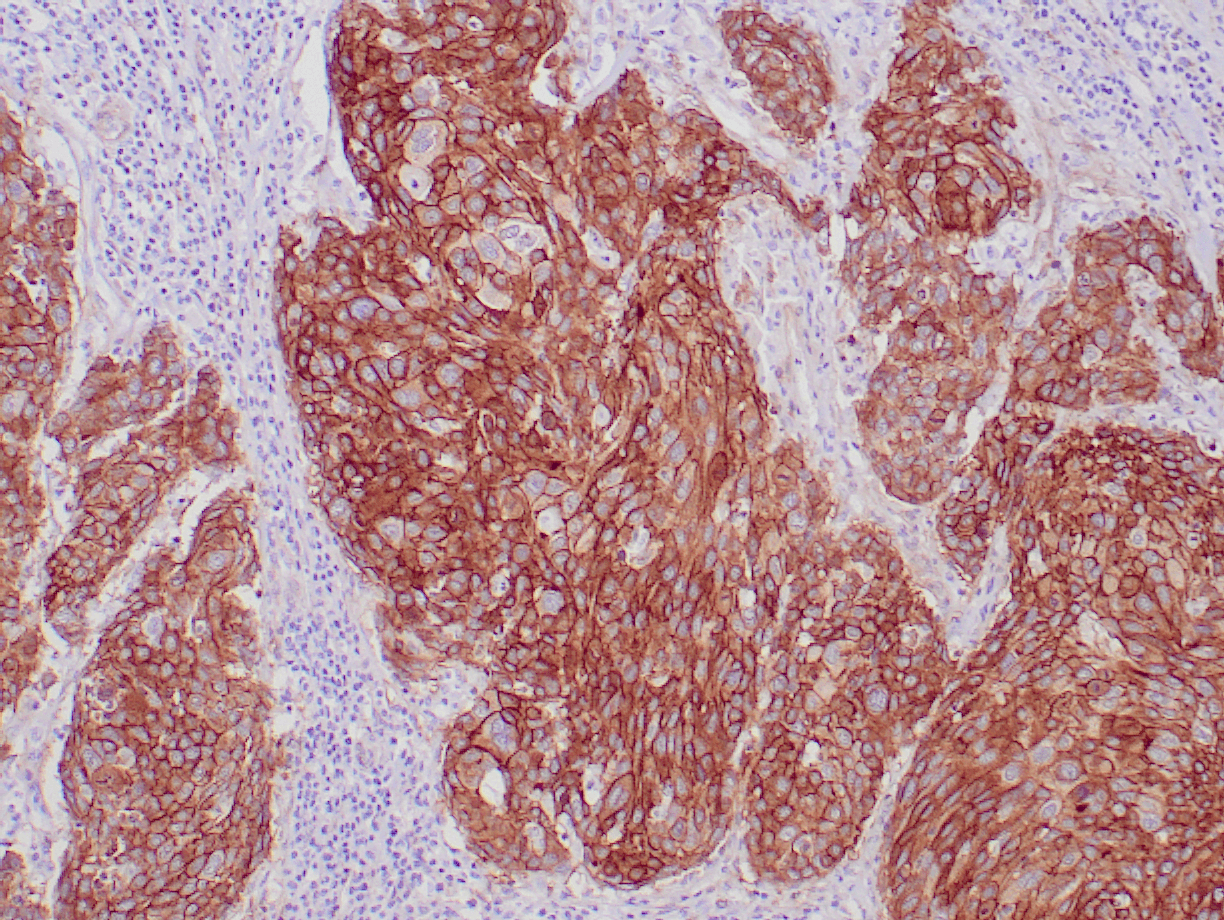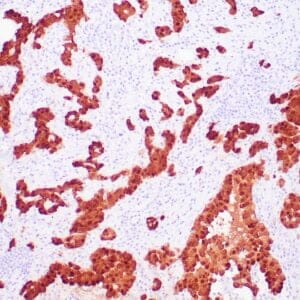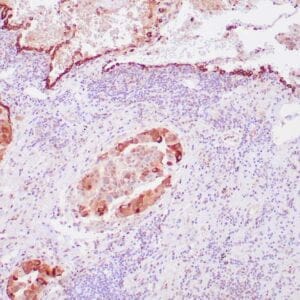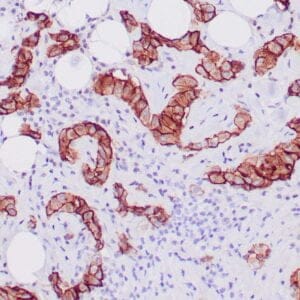| Weight | 1 lbs |
|---|---|
| Dimensions | 9 × 5 × 2 in |
| host | mouse |
| isotype | IgG |
| clonality | monoclonal |
| concentration | concentrate, predilute |
| applications | IHC |
| reactivity | human |
| available size | 0.1 mL, 0.5 mL, 1 mL concentrated, 7 mL prediluted |
rabbit anti-EGFR monoclonal antibody (ZR16) 6167
Price range: $160.00 through $528.00
Antibody summary
- Rabbit monoclonal to EGFR
- Suitable for: Immunohistochemistry (formalin-fixed, paraffin-embedded tissues)
- Reacts with: Human
- Isotype:IgG
- Control: Lung adenocarcinoma
- Visualization: Membranous
- 0.1, 0.5, 1.0 mL concentrated, 7 mL prediluted
rabbit anti-EGFR monoclonal antibody ZR16 6167
| target relevance |
|---|
| Protein names Epidermal growth factor receptor (EC 2.7.10.1) (Proto-oncogene c-ErbB-1) (Receptor tyrosine-protein kinase erbB-1) |
| Gene names EGFR,EGFR ERBB ERBB1 HER1 |
| Protein family Protein kinase superfamily, Tyr protein kinase family, EGF receptor subfamily |
| Mass 134277Da |
| Function FUNCTION: Receptor tyrosine kinase binding ligands of the EGF family and activating several signaling cascades to convert extracellular cues into appropriate cellular responses (PubMed:10805725, PubMed:27153536, PubMed:2790960, PubMed:35538033). Known ligands include EGF, TGFA/TGF-alpha, AREG, epigen/EPGN, BTC/betacellulin, epiregulin/EREG and HBEGF/heparin-binding EGF (PubMed:12297049, PubMed:15611079, PubMed:17909029, PubMed:20837704, PubMed:27153536, PubMed:2790960, PubMed:7679104, PubMed:8144591, PubMed:9419975). Ligand binding triggers receptor homo- and/or heterodimerization and autophosphorylation on key cytoplasmic residues. The phosphorylated receptor recruits adapter proteins like GRB2 which in turn activates complex downstream signaling cascades. Activates at least 4 major downstream signaling cascades including the RAS-RAF-MEK-ERK, PI3 kinase-AKT, PLCgamma-PKC and STATs modules (PubMed:27153536). May also activate the NF-kappa-B signaling cascade (PubMed:11116146). Also directly phosphorylates other proteins like RGS16, activating its GTPase activity and probably coupling the EGF receptor signaling to the G protein-coupled receptor signaling (PubMed:11602604). Also phosphorylates MUC1 and increases its interaction with SRC and CTNNB1/beta-catenin (PubMed:11483589). Positively regulates cell migration via interaction with CCDC88A/GIV which retains EGFR at the cell membrane following ligand stimulation, promoting EGFR signaling which triggers cell migration (PubMed:20462955). Plays a role in enhancing learning and memory performance (By similarity). Plays a role in mammalian pain signaling (long-lasting hypersensitivity) (By similarity). {ECO:0000250|UniProtKB:Q01279, ECO:0000269|PubMed:10805725, ECO:0000269|PubMed:11116146, ECO:0000269|PubMed:11483589, ECO:0000269|PubMed:11602604, ECO:0000269|PubMed:12297049, ECO:0000269|PubMed:12297050, ECO:0000269|PubMed:12620237, ECO:0000269|PubMed:12873986, ECO:0000269|PubMed:15374980, ECO:0000269|PubMed:15590694, ECO:0000269|PubMed:15611079, ECO:0000269|PubMed:17115032, ECO:0000269|PubMed:17909029, ECO:0000269|PubMed:19560417, ECO:0000269|PubMed:20462955, ECO:0000269|PubMed:20837704, ECO:0000269|PubMed:21258366, ECO:0000269|PubMed:27153536, ECO:0000269|PubMed:2790960, ECO:0000269|PubMed:35538033, ECO:0000269|PubMed:7679104, ECO:0000269|PubMed:8144591, ECO:0000269|PubMed:9419975}.; FUNCTION: Isoform 2 may act as an antagonist of EGF action.; FUNCTION: (Microbial infection) Acts as a receptor for hepatitis C virus (HCV) in hepatocytes and facilitates its cell entry. Mediates HCV entry by promoting the formation of the CD81-CLDN1 receptor complexes that are essential for HCV entry and by enhancing membrane fusion of cells expressing HCV envelope glycoproteins. {ECO:0000269|PubMed:21516087}. |
| Catalytic activity CATALYTIC ACTIVITY: Reaction=L-tyrosyl-[protein] + ATP = O-phospho-L-tyrosyl-[protein] + ADP + H(+); Xref=Rhea:RHEA:10596, Rhea:RHEA-COMP:10136, Rhea:RHEA-COMP:20101, ChEBI:CHEBI:15378, ChEBI:CHEBI:30616, ChEBI:CHEBI:46858, ChEBI:CHEBI:61978, ChEBI:CHEBI:456216; EC=2.7.10.1; Evidence={ECO:0000255|PROSITE-ProRule:PRU10028, ECO:0000269|PubMed:15374980, ECO:0000269|PubMed:17349580, ECO:0000269|PubMed:18046415, ECO:0000269|PubMed:18227510, ECO:0000269|PubMed:19560417, ECO:0000269|PubMed:19563760}; |
| Subellular location SUBCELLULAR LOCATION: Cell membrane {ECO:0000269|PubMed:17182860, ECO:0000269|PubMed:20462955, ECO:0000269|PubMed:23589287, ECO:0000269|PubMed:27153536, ECO:0000269|PubMed:2790960, ECO:0000269|PubMed:35538033}; Single-pass type I membrane protein {ECO:0000269|PubMed:27153536}. Endoplasmic reticulum membrane {ECO:0000269|PubMed:27153536}; Single-pass type I membrane protein. Golgi apparatus membrane; Single-pass type I membrane protein. Nucleus membrane; Single-pass type I membrane protein. Endosome {ECO:0000269|PubMed:17182860, ECO:0000269|PubMed:27153536}. Endosome membrane. Nucleus {ECO:0000269|PubMed:17115032, ECO:0000269|PubMed:17909029, ECO:0000269|PubMed:20551055, ECO:0000269|PubMed:20674546}. Note=In response to EGF, translocated from the cell membrane to the nucleus via Golgi and ER (PubMed:17909029, PubMed:20674546). Endocytosed upon activation by ligand (PubMed:17182860, PubMed:17909029, PubMed:27153536, PubMed:2790960). Colocalized with GPER1 in the nucleus of estrogen agonist-induced cancer-associated fibroblasts (CAF) (PubMed:20551055). {ECO:0000269|PubMed:17182860, ECO:0000269|PubMed:17909029, ECO:0000269|PubMed:20674546, ECO:0000269|PubMed:27153536, ECO:0000269|PubMed:2790960}.; SUBCELLULAR LOCATION: [Isoform 2]: Secreted. |
| Tissues TISSUE SPECIFICITY: Ubiquitously expressed. Isoform 2 is also expressed in ovarian cancers. {ECO:0000269|PubMed:17671655}. |
| Structure SUBUNIT: Binding of the ligand triggers homo- and/or heterodimerization of the receptor triggering its autophosphorylation. Heterodimer with ERBB2 (PubMed:10805725). Forms a complex with CCDC88A/GIV (via SH2-like regions) and GNAI3 which leads to enhanced EGFR signaling and triggering of cell migration; binding to CCDC88A requires autophosphorylation of the EGFR C-terminal region, and ligand stimulation is required for recruitment of GNAI3 to the complex (PubMed:20462955, PubMed:25187647). Interacts with ERRFI1; inhibits dimerization of the kinase domain and autophosphorylation (PubMed:18046415). Part of a complex with ERBB2 and either PIK3C2A or PIK3C2B (PubMed:10805725). Interacts with GRB2; an adapter protein coupling the receptor to downstream signaling pathways. Interacts with GAB2; involved in signaling downstream of EGFR. Interacts with STAT3; mediates EGFR downstream signaling in cell proliferation. Interacts with RIPK1; involved in NF-kappa-B activation. Interacts (autophosphorylated) with CBL, CBLB and CBLC; involved in EGFR ubiquitination and regulation; interaction with CBL is reduced in the presence of tensin TNS4 (PubMed:23774213). Interacts with SOCS5; regulates EGFR degradation through ELOC- and ELOB-mediated ubiquitination and proteasomal degradation. Interacts with PRMT5; methylates EGFR and enhances interaction with PTPN6. Interacts (phosphorylated) with PTPN6; inhibits EGFR-dependent activation of MAPK/ERK. Interacts with COPG1; essential for regulation of EGF-dependent nuclear transport of EGFR by retrograde trafficking from the Golgi to the ER. Interacts with TNK2; this interaction is dependent on EGF stimulation and kinase activity of EGFR. Interacts with PCNA; positively regulates PCNA (PubMed:17115032). Interacts with PELP1. Interacts with MUC1. Interacts with AP2M1. Interacts with FER. May interact with EPS8; mediates EPS8 phosphorylation. Interacts (via SH2 domains) with GRB2, NCK1 and NCK2 (PubMed:10026169). Interacts with ATXN2. Interacts with GAREM1. Interacts (ubiquitinated) with ANKRD13A/B/D; the interaction is direct and may regulate EGFR internalization after EGF stimulation. Interacts with GPER1; the interaction occurs in an estrogen-dependent manner. Interacts (via C-terminal cytoplasmic kinase domain) with ZPR1 (via zinc fingers). Interacts with RNF115 and RNF126 (PubMed:23418353). Interacts with GPRC5A (via its transmembrane domain) (PubMed:25311788). Interacts with FAM83B; positively regulates EGFR inducing its autophosphorylation in absence of stimulation by EGF (PubMed:23912460). Interacts with LAPTM4B; positively correlates with EGFR activation (PubMed:28479384). Interacts with STX19 (PubMed:16420529). Interacts with CD44 (PubMed:23589287). Interacts with PGRMC1; the interaction requires PGRMC1 homodimerization (PubMed:26988023). Interacts with PIKFYVE (PubMed:17909029). Interacts with NEU3. Interacts with TRAF4 (PubMed:30352854). Interacts with the ant venom OMEGA-myrmeciitoxin(02)-Mg1a (By similarity). Interacts with CD82; this interaction facilitates ligand-induced endocytosis of the receptor and its subsequent desensitization (PubMed:35538033). {ECO:0000250|UniProtKB:Q01279, ECO:0000269|PubMed:10026169, ECO:0000269|PubMed:10228163, ECO:0000269|PubMed:10805725, ECO:0000269|PubMed:11116146, ECO:0000269|PubMed:11483589, ECO:0000269|PubMed:12297050, ECO:0000269|PubMed:12620237, ECO:0000269|PubMed:12873986, ECO:0000269|PubMed:15282549, ECO:0000269|PubMed:15374980, ECO:0000269|PubMed:15590694, ECO:0000269|PubMed:15837620, ECO:0000269|PubMed:16140940, ECO:0000269|PubMed:16420529, ECO:0000269|PubMed:17115032, ECO:0000269|PubMed:17182860, ECO:0000269|PubMed:17334392, ECO:0000269|PubMed:17909029, ECO:0000269|PubMed:18046415, ECO:0000269|PubMed:18602463, ECO:0000269|PubMed:19172738, ECO:0000269|PubMed:19509291, ECO:0000269|PubMed:19560417, ECO:0000269|PubMed:19563760, ECO:0000269|PubMed:19749156, ECO:0000269|PubMed:19836242, ECO:0000269|PubMed:20462955, ECO:0000269|PubMed:20471394, ECO:0000269|PubMed:20551055, ECO:0000269|PubMed:20674546, ECO:0000269|PubMed:20837704, ECO:0000269|PubMed:21258366, ECO:0000269|PubMed:21518868, ECO:0000269|PubMed:22298428, ECO:0000269|PubMed:22888118, ECO:0000269|PubMed:23418353, ECO:0000269|PubMed:23589287, ECO:0000269|PubMed:23774213, ECO:0000269|PubMed:23912460, ECO:0000269|PubMed:25187647, ECO:0000269|PubMed:25311788, ECO:0000269|PubMed:26988023, ECO:0000269|PubMed:28479384, ECO:0000269|PubMed:35538033, ECO:0000269|PubMed:7657591, ECO:0000269|PubMed:8650580, ECO:0000269|PubMed:9852145, ECO:0000269|Ref.108}. |
| Post-translational modification PTM: Phosphorylated on Tyr residues in response to EGF (PubMed:20462955, PubMed:27153536). Phosphorylation at Ser-695 is partial and occurs only if Thr-693 is phosphorylated. Phosphorylation at Thr-678 and Thr-693 by PRKD1 inhibits EGF-induced MAPK8/JNK1 activation. Dephosphorylation by PTPRJ prevents endocytosis and stabilizes the receptor at the plasma membrane. Autophosphorylation at Tyr-1197 is stimulated by methylation at Arg-1199 and enhances interaction with PTPN6. Autophosphorylation at Tyr-1092 and/or Tyr-1110 recruits STAT3. Dephosphorylated by PTPN1 and PTPN2. {ECO:0000269|PubMed:10523301, ECO:0000269|PubMed:12873986, ECO:0000269|PubMed:16083266, ECO:0000269|PubMed:19563760, ECO:0000269|PubMed:19836242, ECO:0000269|PubMed:20462955, ECO:0000269|PubMed:21258366, ECO:0000269|PubMed:2543678, ECO:0000269|PubMed:27153536, ECO:0000269|PubMed:3138233}.; PTM: Monoubiquitinated and polyubiquitinated upon EGF stimulation; which does not affect tyrosine kinase activity or signaling capacity but may play a role in lysosomal targeting (PubMed:27153536). Polyubiquitin linkage is mainly through 'Lys-63', but linkage through 'Lys-48', 'Lys-11' and 'Lys-29' also occurs. Deubiquitination by OTUD7B prevents degradation. Ubiquitinated by RNF115 and RNF126 (By similarity). Ubiquitinated by ZNRF1 or CBL at different lysines in response to EGF stimulation; leading to recruitment of the ESCRT machinery and subsequent degradation in the lysosomes (PubMed:33996800). Deubiquitinated by UCHL1 leading to the inhibition of its degradation (By similarity). {ECO:0000250|UniProtKB:Q01279, ECO:0000269|PubMed:16543144, ECO:0000269|PubMed:22179831, ECO:0000269|PubMed:22298428, ECO:0000269|PubMed:27153536, ECO:0000269|PubMed:33996800}.; PTM: Palmitoylated on Cys residues by ZDHHC20. Palmitoylation inhibits internalization after ligand binding, and increases the persistence of tyrosine-phosphorylated EGFR at the cell membrane. Palmitoylation increases the amplitude and duration of EGFR signaling. {ECO:0000269|PubMed:27153536}.; PTM: Methylated. Methylation at Arg-1199 by PRMT5 stimulates phosphorylation at Tyr-1197. {ECO:0000269|PubMed:19563760, ECO:0000269|PubMed:19836242, ECO:0000269|PubMed:21258366}. |
| Involvement in disease DISEASE: Lung cancer (LNCR) [MIM:211980]: A common malignancy affecting tissues of the lung. The most common form of lung cancer is non-small cell lung cancer (NSCLC) that can be divided into 3 major histologic subtypes: squamous cell carcinoma, adenocarcinoma, and large cell lung cancer. NSCLC is often diagnosed at an advanced stage and has a poor prognosis. {ECO:0000269|PubMed:15118125, ECO:0000269|PubMed:16533793, ECO:0000269|PubMed:16672372}. Note=The gene represented in this entry is involved in disease pathogenesis.; DISEASE: Neonatal nephrocutaneous inflammatory syndrome (NNCIS) [MIM:616069]: An autosomal recessive disorder characterized by intrauterine growth retardation, premature birth, fragile skin, recurrent skin infections and sepsis, failure to thrive, nephrocalcinosis, and nephromegaly with tubular dysfunction. Some patients have chronic diarrhea, and necrotizing enterocolitis. {ECO:0000269|PubMed:24691054}. Note=The disease is caused by variants affecting the gene represented in this entry. |
| Target Relevance information above includes information from UniProt accession: P00533 |
| The UniProt Consortium |
Data
 |
| Formalin-fixed, paraffin-embedded human lung squamous cell carcinoma stained with anti-EGFR antibody using peroxidase-conjugate and DAB chromogen. Note the membrane staining of carcinoma cells |
Publications
| pmid | title | authors | citation |
|---|---|---|---|
| We haven't added any publications to our database yet. | |||
Protocols
| relevant to this product |
|---|
| IHC |
Documents
| # | SDS | Certificate | |
|---|---|---|---|
| Please enter your product and batch number here to retrieve product datasheet, SDS, and QC information. | |||
Only logged in customers who have purchased this product may leave a review.
















Reviews
There are no reviews yet.